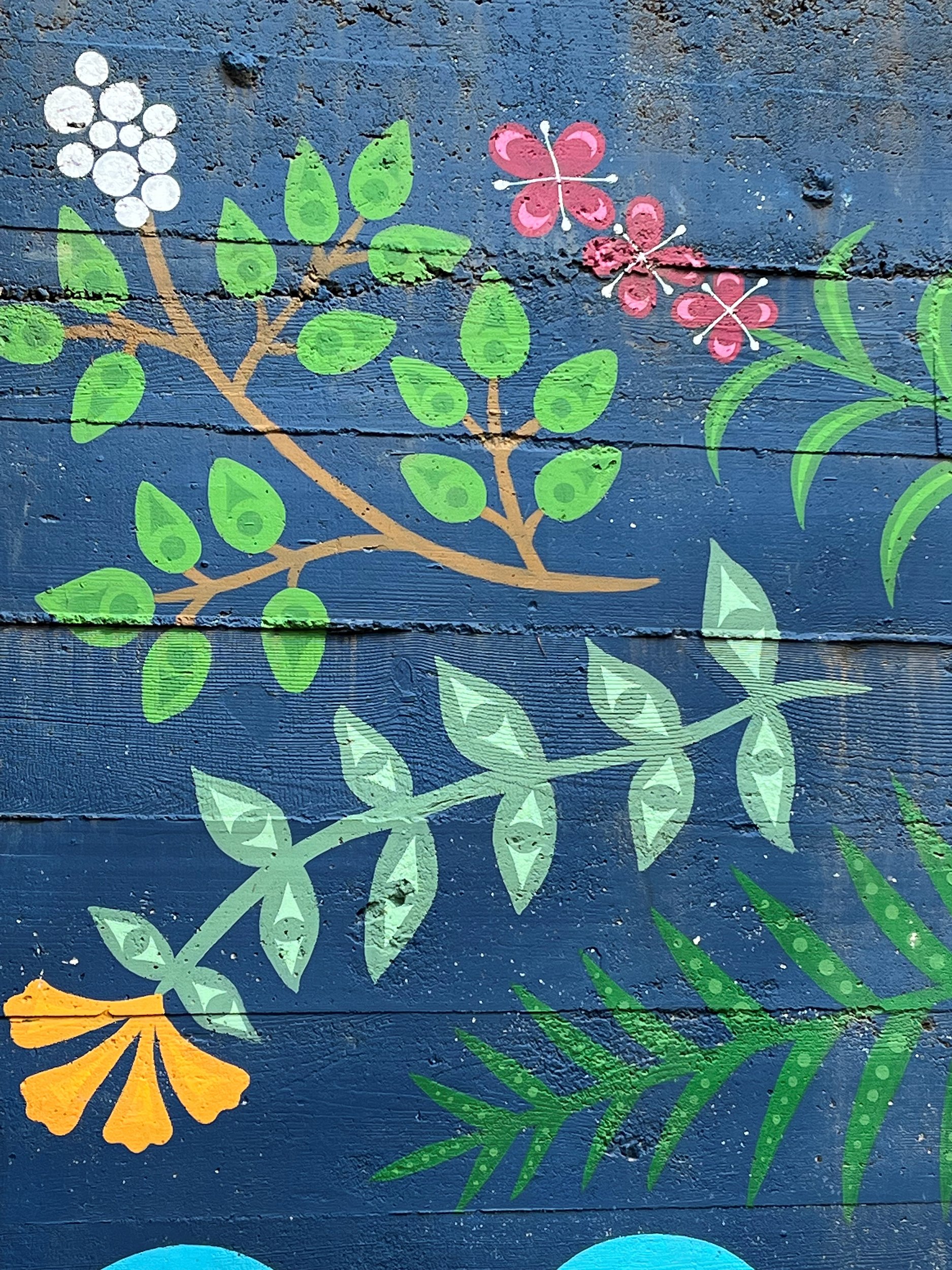March 23rd 2023
Field trip to SṈIDȻEȽ and carving shed
Twenty-eight people took the ferry from Village Bay to Swartz Bay on March 23rd 2023 to participate in a day long field trip, guided by the Mayne Island Conservancy and funded by the Campbell Bay Music Festival Society through a generous grant from Heritage BC.
The day began with a land acknowledgement: “With gratitude, we respectfully acknowledge that we are gathering today on the unceded traditional territory of the W̱SÁNEĆ people who have cared for and lived on this land for millennia. We are grateful to them for looking after the rich resources and cultural teachings of this beautiful land. We come to our work today with open hearts and minds and look forward to working and learning together in a good way”.
Our community bus driver navigated us to the trailhead on Wallace Road, from where we walked the forest path through Gowland Tod Park to SṈIDȻEȽ (snee/ kwidTH) on Tod Inlet, the first village site of the W̱SÁNEĆ people. Our project was to spend a few hours with the PEPÁḴEṈ HÁUTW̱ Foundation staff, Judith Arney, Sarah Jim, and Kyle Clark, learning on the Land and helping towards restoring the native eco system.
Sarah, a W̱SÁNEĆ community member from Tseycum village, shared this story with us. SṈIDȻEȽ is a major place to the W̱SÁNEĆ peoples. SṈIDȻEȽ means “Place of the Blue Grouse” in SENĆOŦEN. Blue grouse is an indicator species for the W̱SÁNEĆ; their presence told the people that food resources were abundant in its chosen habitat. Ancient shell middens from the long W̱SÁNEĆ occupation of SṈIDȻEȽ are found throughout the area, supporting the claim that the area was once a rich site for shellfish. The inlet was a perfect village site, offering a place of shelter from the cold winds of winter. The area was, and still is, a key area for edible and medicinal plants used by the Nation.
SṈIDȻEȽ is a very sacred place. The W̱SÁNEĆ connection to this place goes back to the very beginning of W̱SÁNEĆ history. Elder J’SINTEN (Dr. John Elliott, Tsartlip First Nation) tells the story of the very first W̱SÁNEĆ person named SLEMEW̱ (Rain) being placed here by XALS (the Creator). The W̱SÁNEĆ people lived at SṈIDĆEȽ for centuries until the 1600s, when a Haida raiding party came and burned the village here. Afterwards the survivors of this raid left to found the two villages currently known as W̱JOȽEȽP (Tsartlip) and SȾÁUTW̱ (Tsawout). The people would return to the village site to collect shellfish and to hunt and gather food.
From 1904-1913 the Portland Cement Company operated a limestone quarry in SṈIDȻEȽ, seriously impacting the lands and waters in this special place. Houses built for managerial staff were inhabited until the 1950s. In the 1970s local firefighters burned the derelict structures as a practice exercise for their crews. The ruins of these buildings can still be seen in the forests at SṈIDȻEȽ. The PEPÁḴEṈ HÁUTW̱ Foundation works in collaboration with the Tsartlip Lands Committee, BC Parks, W̱SÁNEĆ knowledge keepers and specialists to guide the restoration of this site.
Our island crew had the opportunity to give back in a small way by helping to restore the native ecosystem at SṈIDȻEȽ. With gloves, boots, trowels, shovels, and tarps we walked to an area inundated with invasive blackberry and buttercup. In the same area were wild strawberry plants (DI,LEK IŁĆ; t’ileqw-ilhch) peeking through as well as ocean spray KÁŦEŁĆ, q’ey’t’th-alccj and nootka rose, KELKE IŁĆ; qel’eq-ilhch. Our job was to carefully remove the buttercup , revealing and giving light to the strawberries, as well as to dig out the blackberry by the roots leaving space for the native plants. We all went to work with great gusto and a couple of hours later we had cleared patches of the ground. The offending blackberry and buttercup were collected on tarps and removed to a distant spot where the Foundation staff would make sure it was dealt with properly.
After a closing circle of reflection on our day’s work, we climbed aboard the bus and headed off for a hearty lunch and an hour of conversation in Brentwood Bay. Then it was off to visit artist Chazz TEMOSEN Elliot at the carving shed on W Saanich Road built by his father, master carver Charles TEMOSENŦET Elliott, where the two welcome poles are being carved for the entrance to the Mayne Island Farmers Market.
Laid out in the studio was a display of many carved pieces. From big story poles and animal figures still in process to carved and painted spindle whorls, halibut hooks, bailers, masks, maquettes of poles and more, Chazz shared stories of the pieces, his family ancestry and artistic tradition, and the meaning of the carvings and the use of the pieces. His mother, weaver Myrna Elliott, was there; she shared how she learned Salish weaving, and her practice of hand spinning the wool, using natural dyes to colour the wool, and the process of weaving on a traditional Salish loom.














